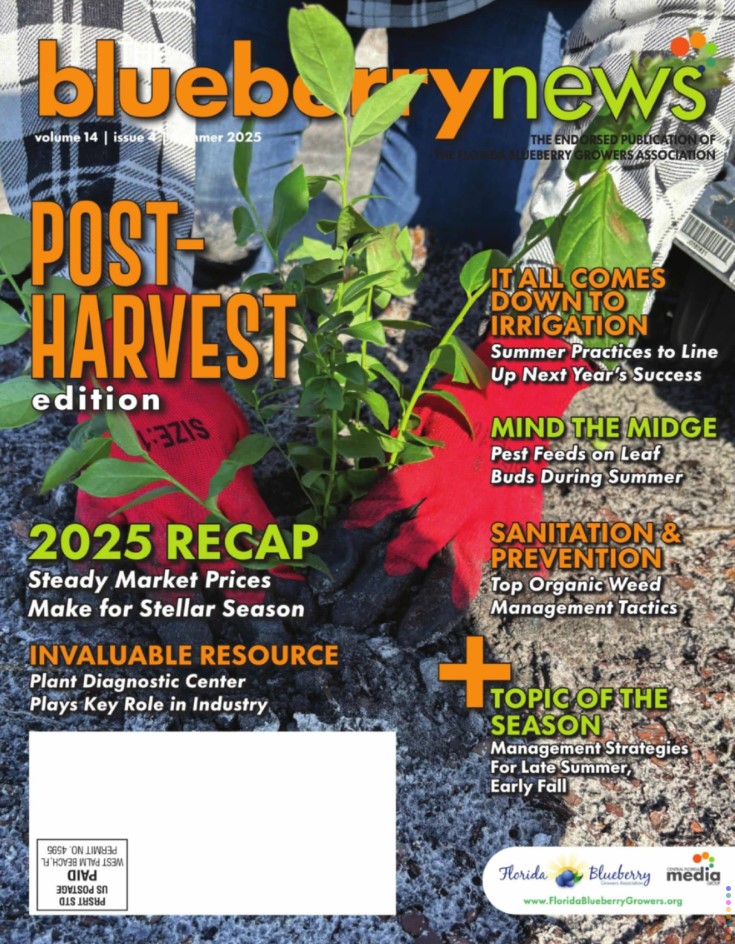Florida Growers Report Rebound After a Weak 2020
by PAUL CATALA
At the end of March 2021, USDA Market News via Agronometrics, a market performance analysis for the fresh produce industry, was optimistic about the Florida blueberry season.
At that time, Argonometrics’ analysis showed unexpectedly high spot pricing for the 2021 crop than what was reported for the 2019 and 2020 seasons. Fortunately for blueberry growers across Florida, that prediction was right.
Throughout 2021, the prices of blueberries in the North American market remained high, their highest point in weeks 15 and 16 of 2021, where average prices were $5.30 per pound — a 73 percent increase year-on-year.
It’s a bit early to report exact harvest figures for 2021, but according to Brittany Lee, executive director of the Florida Blueberry Growers Association (FBGA), the economic impact of the Florida blueberry harvest for 2021 is predicted to be up to $200 million.
With the coronavirus pandemic in full effect in 2020, that year’s season only yielded about 17.05 million pounds of blueberries on about 5,500 acres, harvested statewide from mid-April through May, according to the FBGA.
Generally, exact blueberry economic impact numbers from the USDA are not released until about a year after a given year’s harvest, adds Lee.
“Pricing was strong through April; I would expect when the official USDA numbers come out, they will show a good year for Florida blueberries,” Lee says about the state’s blueberry revenue for 2021. “We had a solid production year; it was strong statewide.”
In its 2020 State Agricultural Overview, the USDA reported a total of about 20 million pounds of commercial, utilized blueberries with a commercial production value of $51 million.
By the end of the 2021 season, the FBGA reported Florida’s blueberry growers harvested 21.89 million pounds, not far from the 22.7 million pounds harvested in 2019 before the pandemic hit.
“Growers in 2020 didn’t harvest all of their blueberry production because of depressed pricing due to the coronavirus pandemic, but for 2021, we have bounced back to a more stable year in pricing and production,” adds Lee.
That bounce back was evident in feedback collected by Doug Phillips, UF/IFAS blueberry extension coordinator based in Balm. He says post-season, he went to growers to ask about their harvest results and found most said they had strong harvests. He says the only issues he heard were related to pollination, which resulted in slightly smaller harvests than expected.
“I think overall, most growers reported production was good and prices stayed pretty stable throughout the season. Every season stands on its own with different issues — weather, insects, disease, the market,” says Phillips, who’s been with IFAS for 3 ½ years. “For 2022, I think it looks good now. I don’t know why it wouldn’t be good but there are always unexpected events and variables to factor in any season.”
Although not nearly a record for Florida’s blueberry growers and their crops, the market is trending upward again, says Chris Velasco, manager of Blueberry Bunch Farm, LaBelle.
On the farm’s 35 acres, Velasco, says Blueberry Bunch is in its 15th year as a commercial farm and 2021 was the third year Blueberry Bunch offered a u-pick option. There are about 50,000 bushes — 9,000 of those organic, planted this past season — on the property.
Velasco, who lives in Fort Myers, says that after the slow 2020 season, the 2021 harvest – along with u-pick revenue – was more profitable and he feels the upcoming season will continue that trend.
“The market was good; things picked up,” says Velasco.
“There was progress. We hope every year to increase the harvest as more people become aware of the farm. Everything is picking up from 2020.”
Dawn: Make this an info box
Helpful Tool for Growers
The USDA website offers a helpful tool for tracking and assessing blueberry production and shipments.
Go to https://marketnews.usda.gov/mnp/fv-home and click on “Movement” under Standard Reports. Select “Run a Custom Report.” On the next page, start choosing the commodity and the time range breakdown for how you’d like your data. While daily reports can give helpful feedback, you can also get the data broken down by weeks or even seasons (by the month).





